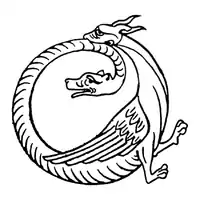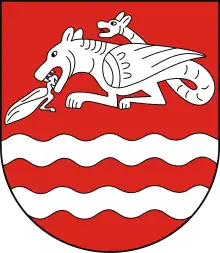Amphisbaena
The amphisbaena (/ˌæmfɪsˈbiːnə/, plural: amphisbaenae; Ancient Greek: ἀμφίσβαινα) is a mythological, ant-eating serpent with a head at each end. The creature is alternatively called the amphisbaina, amphisbene, amphisboena, amphisbona, amphista, amfivena, amphivena, or anphivena (the last two being feminine), and is also known as the "Mother of Ants". Its name comes from the Greek words amphis, meaning "both ways", and bainein, meaning "to go".


Mythology
According to Greek mythology, the amphisbaena was spawned from the blood that dripped from the Gorgon Medusa's head as Perseus flew over the Libyan Desert with her head in his hand, after which Cato's army then encountered it along with other serpents on the march.[1] Amphisbaena fed on the corpses left behind. The amphisbaena has been referred to by various poets such as Nicander, John Milton, Alexander Pope, Percy Bysshe Shelley, Alfred, Lord Tennyson, Aimé Césaire, A. E. Housman and Allen Mandelbaum; as a mythological and legendary creature, it has been referenced by Lucan, Pliny the Elder, Isidore of Seville, and Thomas Browne, the last of whom debunked its existence.
Appearance

The amphisbaena has a twin head, that is one at the tail end as well, as though it were not enough for poison to be poured out of one mouth.
The Amphisbaena however is a snake with two heads, one at the top and one in the direction of the tail. When it advances, as need for a forward movement impels it, it leaves one end behind to serve as tail, while the other it uses as a head. Then again if it wants to move backwards, it uses the two heads in exactly the opposite manner from what it did before.
The amphisbaena grows twin heads, one in the proper place, and the other where the tail should be. For this reason the snake glides in a circular shape, as the heads, contrary to what is right, strain from both ends.
These early descriptions of the amphisbaena depicts a venomous, dual-headed snakelike creature. However, Medieval and later drawings often show it with two or more scaled feet, particularly chicken feet, and feathered wings. Some even depict it as a horned, dragon-like creature with a serpent-headed tail and small, round ears, while others have both "necks" of equal size so that it cannot be determined which is the rear head. Many descriptions of the amphisbaena say its eyes glow like candles or lightning, but the poet Nicander seems to contradict this by describing it as "always dull of eye". He also says: "From either end protrudes a blunt chin; each is far from each other." Nicander's account seems to be referring to what is indeed called the Amphisbaenia, a group of real lizards.
Habitat

The amphisbaena is said to make its home in the desert.
Folk medicine
In ancient times, the supposedly dangerous amphisbaena had many uses in the art of folk medicine and other such remedies. Pliny notes that expecting women wearing a live amphisbaena around their necks would have safe pregnancies; however, if one's goal was to cure ailments such as arthritis or the common cold, one should wear only its skin.[4] By eating the meat of the amphisbaena, one could supposedly attract many lovers of the opposite sex, and slaying one during the full moon could give power to one who is pure of heart and mind.[5] Lumberjacks suffering from cold weather on the job could nail its carcass or skin to a tree to keep warm, while in the process allowing the tree to be felled more easily.[6]
Origins
In The Book of Beasts, T.H. White suggests that the creature derives from sightings of the worm lizards of the same name.[7] These creatures are found in the Mediterranean countries where many of these legends originated.
In media
In John Milton's Paradise Lost, after the Fall and the return of Satan to Hell, some of the fallen angelic host are transformed into the amphisbaena, to represent the animal by which the Fall was caused, i.e. a snake.[8]
The amphisbaena is mentioned in the first book of Andrzej Sapkowski's The Witcher series, i.e. The Last Wish, when The Witcher's protagonist, Geralt of Rivia, is recalling past events when he meets an old acquaintance named Irion. The amphisbaena was endangering the region of Kovir until the beast was slain by Geralt's hand.
Brandon Sanderson's novel Skyward has a character whose name is Arturo Mendez. His call sign is amphisbaena.
In the 1984 Scandinavian animated film Gallavants, an amphisbaena (called in the film as a 'Vanterviper') appears as a minor antagonist. The two heads, a red one named Edil and a blue one called Fice, frequently disagree and argue, and sing a song about their miserable plight.
Amphisbaena appears in some editions of the tabletop roleplaying game Dungeons & Dragons.
The Amphisbaena appears in the Rise of the Teenage Mutant Ninja Turtles episode "Battle Nexus: New York." This version is one of the known champions of the Battle Nexus. Big Mama had Michelangelo and Meat Sweats compete to feed each of its heads in order to satisfy. They managed to work together to pull it off.
Amphisbaena has appeared in several video games as an enemy or boss monster, including La-Mulana and Bravely Second: End Layer. A creature called Amphisbaena appears in the games Castlevania: Symphony of the Night and Castlevania: Portrait of Ruin but bears little resemblance to other renditions of the creature, appearing as an eyeless 4-legged reptile creature with the upper body of a human woman sprouting from its long tail instead of a double-headed serpent.
References
- "When Cato the Younger's army marched through Libya". Archived from the original on 2014-12-22. Retrieved 2014-11-30.
- Aelian, Characteristics of Animals, 9.23
- Solinus, Polyhistor, 27.29
- Puttock, Sonia (2002). Ritual significance of personal ornament in Roman Britain. Oxford: Archaeopress. p. 93.
- "Amphisbaena". Mythical-Creatures-and-Beasts.com. Retrieved 2019-02-19.
- "Amphisbaena - All About Dragons". allaboutdragons.com. Retrieved 2019-02-19.
- The Book of Beasts
- Paradise Lost, 10.524
Bibliography
- Hunt, Jonathan (1998). Bestiary: An Illuminated Alphabet of Medieval Beasts (1st ed.). Hong Kong: Simon & Schuster. ISBN 0-689-81246-9.
- Levy, Sidney J. (1996). "Stalking the Amphisbaena", Journal of Consumer Research, 23 (3), Dec. 1996, pp. 163–176.
External links
| Wikimedia Commons has media related to Amphisbaena in art. |